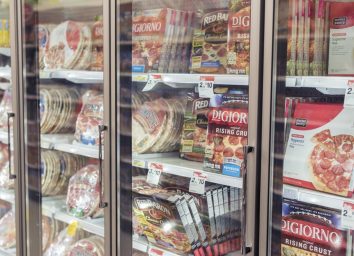5 Freezer Aisle Brands to Stay Away From Right Now
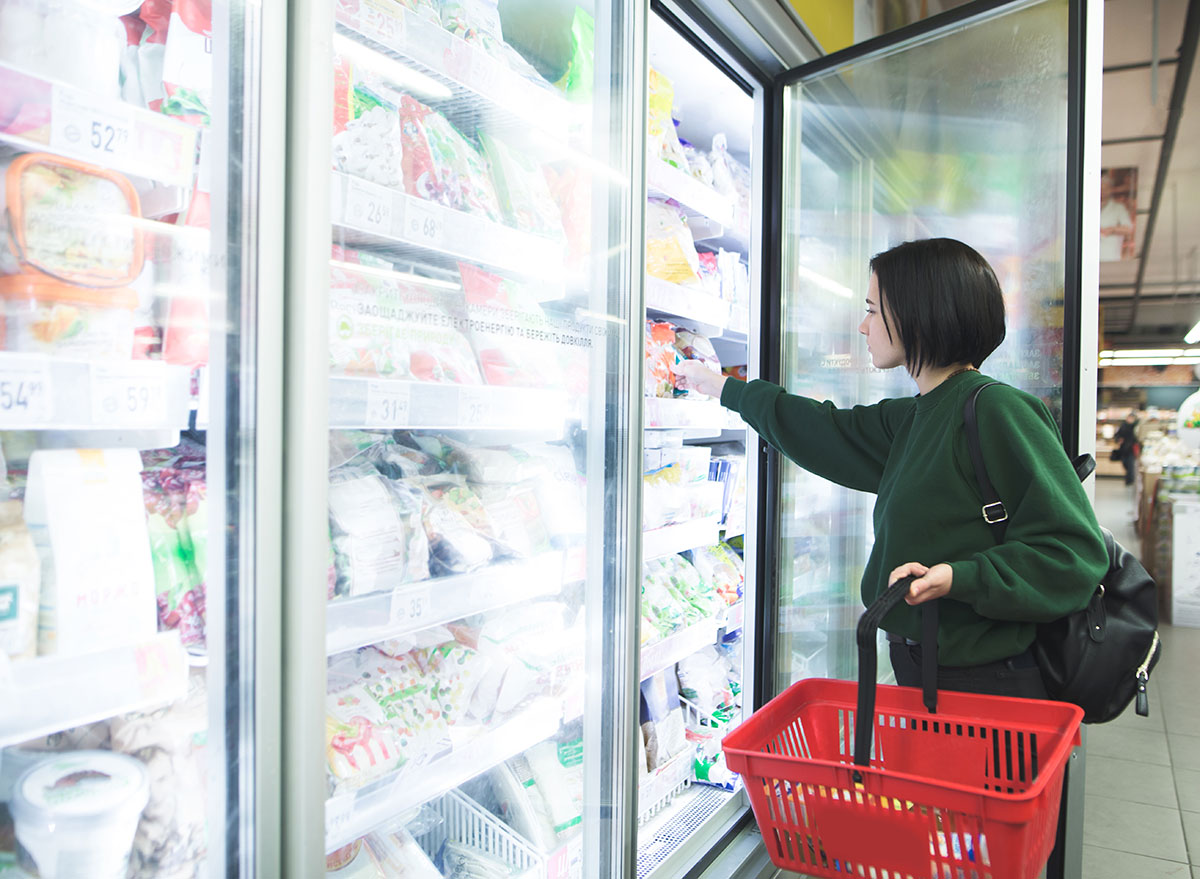
Does your weekly trip to the grocery store always include a stroll down the freezer section? You're certainly not alone. Frozen foods have always been popular in the United States, but sales have seen a spike ever since COVID-19. Per Quartz, frozen food sales during January 2022 were up by an astounding 26% in comparison to January 2020.
The pandemic complicated all of our lives, but frozen foods offer simplicity. Putting together a freshly cooked dinner can take hours. A frozen meal can be ready in two minutes.
Saving time isn't the only reason people keep returning to the frozen food aisle. One study, published in the Journal of Nutrition Education and Behavior, asked over 150 parents why they buy frozen food for their families. While saving time was the top answer (57%), just under half (49%) also said their families legitimately enjoy the food.
Another 27% said they buy frozen food to save money. That research was conducted in 2017, but considering the financial burden of the pandemic and its aftermath on so many families, money concerns likely contributed to the boom in frozen food sales.
Moreover, recent consumer survey data from 2021 suggests younger generations generally place frozen foods on about the same nutritional level as fresh options. For example, 51% of surveyed 18 to 34-year-olds said frozen meat is just as good or better than fresh meat. Another 47% of that age bracket said the same regarding frozen seafood.
Young Americans aren't necessarily wrong. Not everything in the frozen food section is unhealthy. Frozen berries, for instance, are still loaded with vitamins and antioxidants.
That being said, many frozen meals and snacks tend to be loaded with preservatives, processed meat, and ridiculous amounts of sodium and saturated fat. We did some investigating and identified five of the unhealthiest brands populating grocery store freezers all over the country.
And don't miss 4 Meat Companies With the Worst Food Quality Practices.
Hungry-Man
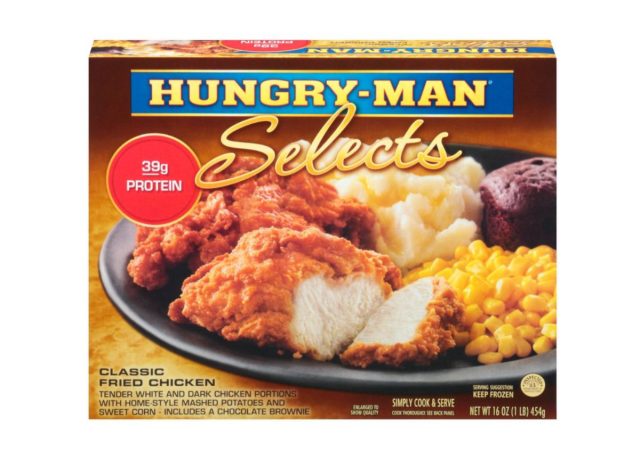
Hungry-Man is the quintessential frozen TV dinner. Inviting consumers to "eat like a man," Hungry-Man meals usually consist of meat, a side dish like mashed potatoes, a vegetable, and a dessert brownie.
The brand offers a wide assortment of meals, from Salisbury steak to roast turkey, but one troubling consistency across all of them is the ridiculously long list of ingredients.
"These frozen meals are a great example of heavily-processed food, which is evident from the very long ingredient list each of these products has. While they may be convenient, eating too many unhealthy ingredients can lead to weight gain, heart disease, and other serious health problems," explains nutrition Jay Cowin, Director of Formulations at ASYSTEM.
"Hungry-Man produces some of the unhealthiest frozen foods on the market. A single Hungry Man meal can contain from 500 to 1,000 calories, and up to half of those calories can come from fat," he says.
The absolute worst Hungry-Man meal out there? Steer clear of the Classic Fried Chicken meal. A single serving contains 950 calories, 57 grams of fat, and 1,840 milligrams of sodium.
Make better eating choices every day by signing up for our newsletter!
Kid Cuisine
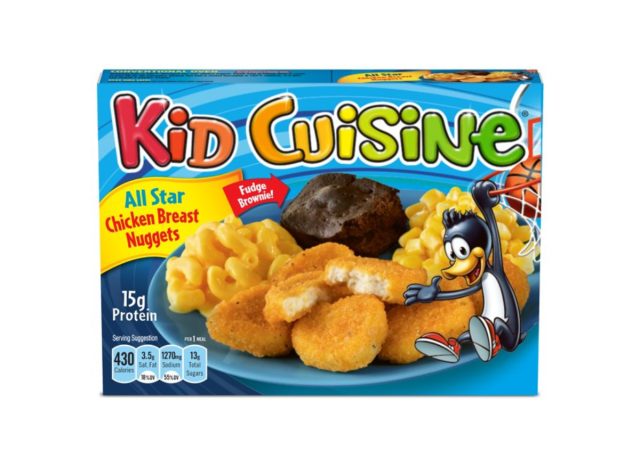
Once named the worst packaged lunch for kids in America by NBC, Kid Cuisine is essentially the mini version of Hungry-Man meals.
The portions may be smaller, but the excessive use of sodium remains. Consider Kid Cuisine's All Star Chicken Nuggets. Just one serving contains 1,180 milligrams of sodium. That's over half the amount of sodium anyone, let alone a child, should consume in one day. Oh, and there's also 10 grams of added sugar to boot.
Considering how important a proper diet is for a growing body, Kid Cuisine is better left on the freezer shelf. There are plenty of healthier frozen alternatives for your kids, such as Kidfresh. Their chicken nuggets contain no preservatives and use white meat chicken never given antibiotics.
White Castle
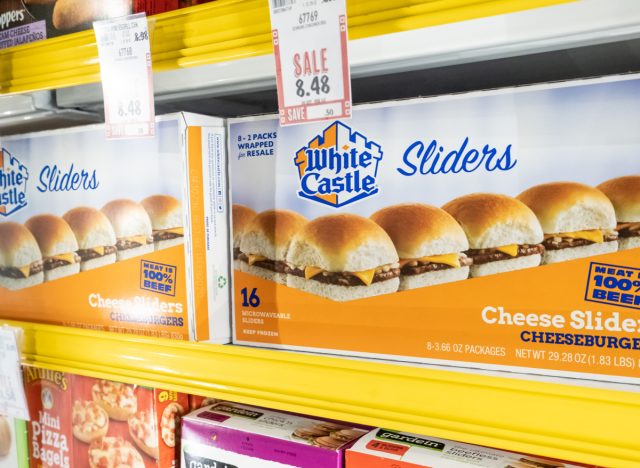
An iconic fast-food brand, White Castle also offers a wide variety of frozen grocery slider options. There are even breakfast sliders, but eating just two delivers 1,190 milligrams of sodium (52% of recommended daily intake) to start the day.
White Castle's frozen sliders are very small, but don't equate their compact size to leaner eating. Just one cheeseburger slider contains about nine grams of overall fat, four grams of saturated fat, 170 calories, and 310 milligrams of sodium!
"If you like their fast food, you might be tempted to try one of their frozen meals, such as the sliders. However, you will be quickly disappointed. These sliders are soggy, flavorless, and chewy. Also, they contain no fiber and far too much sodium," comments nutritionist Juliana Tamayo from Fitness Clone.
A serving size is two sliders, but considering how little dietary fiber these foods offer, chances are you'll still feel hungry after a "serving" or two.
Hot Pockets
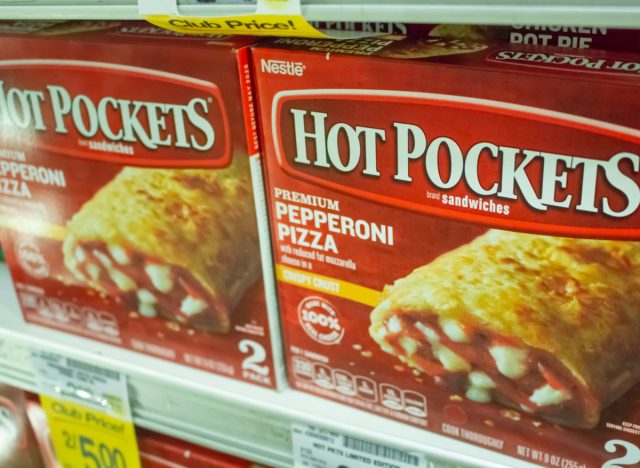
About as synonymous with the frozen food aisle as ice, Hot Pockets can be found in millions of freezers across America. While certainly convenient, the Hot Pockets brand has dealt with its fair share of controversy lately. Just last year Nestlé recalled over 750,000 pounds of Hot Pockets over concerns the foods "may contain pieces of glass and plastic."
Putting that incident aside, how do Hot Pockets fare as far as nutrition goes? Not so hot.
"Hot pockets are packed with sodium, saturated fats, and a laundry list of ingredients that include preservatives and additives," Cowin explains. "Additionally, they are also high in calories, leading to weight gain if eaten regularly. One singular pepperoni hot pocket already contains 320 calories, but this isn't enough to keep you full for a while, so you'll end up eating more!"
When actor Jason Segel was preparing for a movie role, he famously relied on a "Hot Pocket diet" to help him gain 40 pounds in a matter of weeks. While Segel's situation was extreme—he was reportedly eating two Hot Pockets every three hours—the general point still stands. Eating Hot Pockets regularly isn't an ideal dietary choice.
"I suggest making your own pizza pockets at home with whole wheat dough and healthy fillings like grilled chicken, vegetables, and low-fat cheese for a healthier alternative," Cowin adds.
Ben & Jerry's
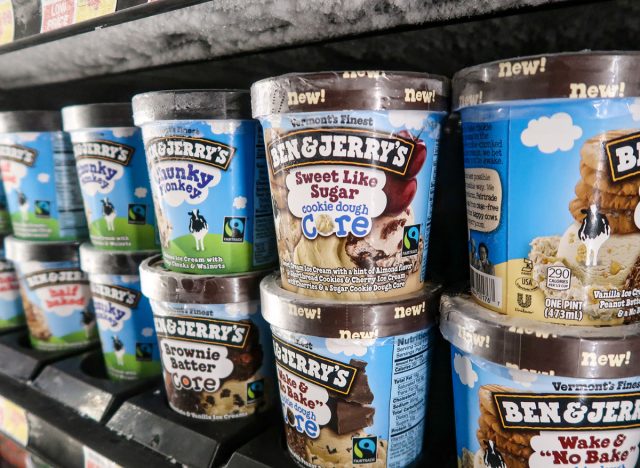
Generally, it's hard to argue with a straight face that Ben & Jerry's ice cream isn't delicious. Big flavor, however, means a heavy nutritional toll.
"I'm not a fan of demonizing certain foods, but the healthier choice is to go with an ice cream brand that doesn't average over 6 teaspoons of sugar per serving—yes you read that right!" says Kuudose's celeb health expert Joey Thurman. "The American Heart Association (AHA) says women should only have 24 grams or 6 teaspoons (no more than 100 calories) of added sugar per day, while men should stick to no more than 36 grams or 9 teaspoons."
Let's take a look at the ice-cream giant's Netflix & Chilll'd flavor. Just one serving, or two-thirds of a cup, contains 24 grams of fat, 10 grams of saturated fat, 390 calories, and 29 grams of total sugar (24 grams added). If you eat the whole cup (it happens!) that would mean ingesting an astounding 72 grams of added sugar (or 144% of your daily recommended value).
"While it's fine to indulge in these treats every once in a while, eating them regularly can lead to weight gain, diabetes, and other serious health problems," Cowin concludes. "If you're looking for a healthier alternative to Ben & Jerry's, I suggest trying out Halo Top instead. Halo Top has a lot of low-calorie, low-sugar, and high-protein ice cream that comes in various delicious flavors."


